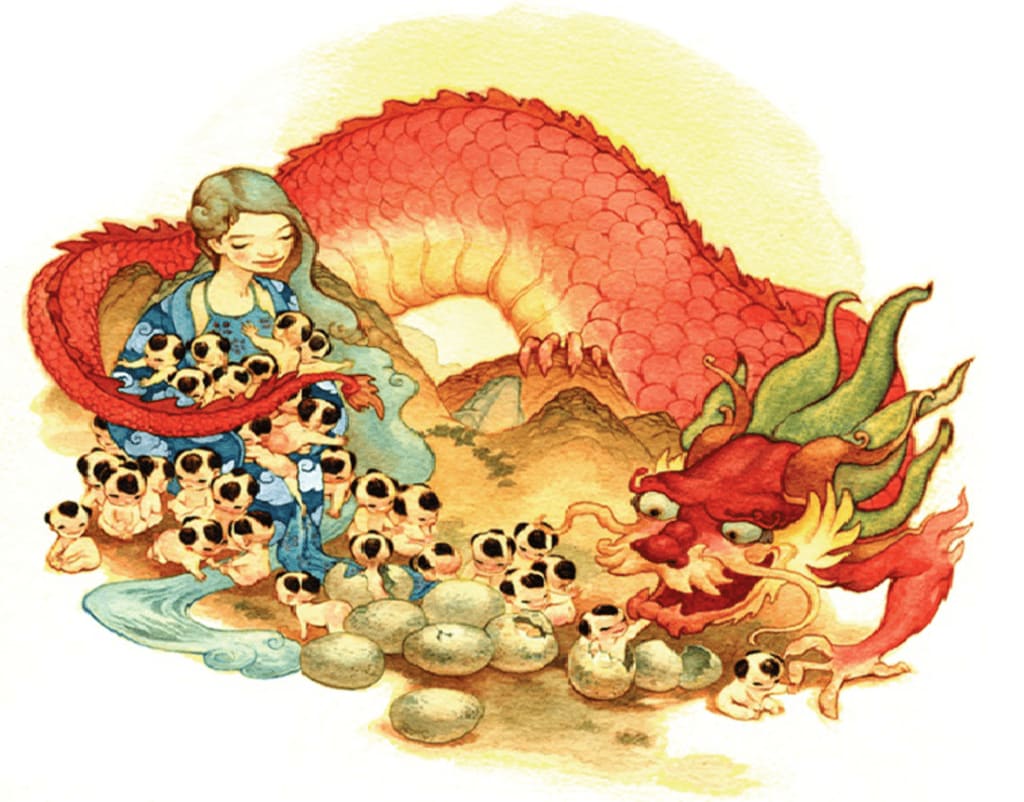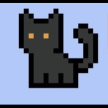Vietnam's Creation Myth: The Prologue (Pt. 1)
Water Dragons, believe it or not, played a big role in Vietnam as we know it today.

**Note: Since there is a strict no-pictures policy at The Water Palace, every piece of illustration will either be artist renditions or approximations.
**This was originally uploaded on my Substack. Head over to there to subscribe to my newsletter so you don't miss any episode of Vietnam's Creation Myth.
Our story begins here.
Vietnam existed before LẠC LONG QUÂN, The Dragon, and ÂU CƠ, The Allmother. But before we get to know them, we have to go back before they were even conceived, when the country was supposedly called Xích Quỷ (Red Demon) around 2000 B.C. “Supposedly,” because no one thinks it existed. But would something call The Red Demon care about what people think? And so Xích Quỷ lived, not caring a thing about the world around. The thing didn’t even bulge when a Dragon died of old-age on its side – The Demon always sleeps on its side, in a fetal position that makes its crimson body look like an S when viewed from above.
Thanks for reading Vu’s Substack! This is the first of my Vietnam's Creation Myth series, where I retell my country's mythology. Episodes will be out every Wednesday on here and Substack. Thank you for your time.
Of course, such nonchalance was going to row some people, and one of them was the grandfather of LẠC LONG QUÂN, King Đế Minh. Đế Minh was himself, a descendant of a God, and thus felt it was obvious that everyone should pay attention to him. He, rather predictably, failed to even stir Xích Quỷ, for it was difficult to hear a shouting ant, especially when a Dragon is fossilizing on your side, and you haven’t been getting your beauty sleep in. Angry and frustrated, Đế Minh did what all rich, entitled, angry and frustrated people do: let those who are more capable handled the job, in this case, it was his son and father of Lạc Long Quân, LỘC TỤC. By this time, the Dragon’s bones had fossilized nicely, turning into a mountain range so magnificent Mount Olympus felt threatened.
There have never been records of and if Lộc Tục ever faced or defeated the Red Demon, or merely let him enjoy his slumber, but soon afterward we knew Lộc Tục claimed the whole of the Demon to be his, ruling over the tribesman and smaller deities and wandering spirits that was inhabiting the giant body. Among the inhabitants was also the Water Dragonkin, whose ancestor died and became the mountainside (allegedly). And among these dragonkins was LONG NỮ, daughter of Động Đình Quân the Dragon King, and soon-to-be wife of LỘC TỤC (now known as KINH DƯƠNG VƯƠNG). Lạc Long Quân, then, was half Dragon, and it would be remiss not to delve into these beautiful beings.
Water Dragons, as their name suggested, have their palace under a lake formed from the Demon’s navel. To visit the Water Palace (Thủy Cung, or Dragon Palace, Long Cung. These names are used interchangeably) one only needed a strong nose, for the water was clear enough to see all the way to the bottom (if you got lost, just swim up).
Arriving at the front door, you will be confronted by two shrimps in armour (outside of their carapace of course) who will ask you the reason for your visit. Present them with the correct paperwork and identifications, and the gates would open, welcoming you to the Inner Court. Imagine Disneyland, where you can see The Palace from afar, but first, you were going to have to drive the economy by purchasing from the markets located right in front of your eyes.
It is a typical market you would see in this part of the world (minus the underwater part, and minus the fish people, and no, they do not sell fish), where you will get dragged, haggled, bargained, sweet-talked, screamed at, until you find yourself five minutes later with a tattoo, a dog collar, a sun-dress (with a surprising, one-in-a-life-time 80% sales), and finger-foods (or webbed-foods? tentacled-foods?) of dubious origins (best not asked, pray it’s not fish)… Here you will also see, strangely, only one type of fishpeople: the mermaids and mermen, whose upper-halfs are that of humans (the gills on the neck are barely visible in the dark), and lower-halfs of different marine animals. Their outfits do not vary much from one another either, with females opted for long dresses made from stitching different fabrics together and no pants! Males, then, could go full commando and no one would have batted an eye.
What other choices did they have, really? They either had to imitate clothing from those above ground, or they were dressed like fishfolks that were more fish-like, and the fishfolks did not appreciate that in the slightest. Besides, they already have some inter-mingling with the humans anyway. And they were the only ones that lived in houses.
The Nobles lived in holes, luxurious, gold-walled, gemstone-ceilinged, 465 square meters holes that surrounded The Palace like tactical moats. These holes not only acted as borders to keep the commoners out, but were also strategically built there so the nobles would always be the first to meet the dragonkins, like ants to a honeypot. Or fish to bait. An interesting question arises here:
The short answer is: why would fish wear pants? What would they have to cover? The long answer is: Fishfolks have always been an extremely prideful bunch, and deemed any societal constraints seen on dryland too below them and hated the merfolks for putting on any fabric at all to cover themselves. They hated the merfolks for other reasons, too, of course. One thing was clear, however, they enjoy luxury and wealth. A Basa Noble would often be seen with their fins adorned with different sets of jewelry for different days of the week, and their scales pierced with a variety of gemstones. Stood out the most, however, are catfish. Besides the obvious demonstration of wealth, according to their curriculum vitae, most of them have experience as advisors for the Dragon King himself, or at least his advisors’ advisors, who, coincidentally, are also catfishes. It must be something about their whiskers that denoted certain qualities as advisors, for what else signified “deep in thought” better than a twirling of whiskers?But what can those devious, brilliant facial hair convey? When will our main characters be conceived? Those are all questions for the future, I’m afraid.
Next time, however, there be Dragons. Not wyverns, not wyrms, but the antler-headed, three-clawed, body-the-length-of-the-river-Nile type (See the artist rendition above, or better yet, go watch Spirited Away. Miyazaki must have had personal experience with them).
About the Creator
Vu Phan
A Vietnamese writer. I retell Vietnamese Mythology for the global audience, or at least I am trying to. I also write down random thoughts I manage to catch during a run. I am a postmodernist, and my favourite author is Neil Gaiman.
Enjoyed the story? Support the Creator.
Subscribe for free to receive all their stories in your feed. You could also pledge your support or give them a one-off tip, letting them know you appreciate their work.






Comments
There are no comments for this story
Be the first to respond and start the conversation.